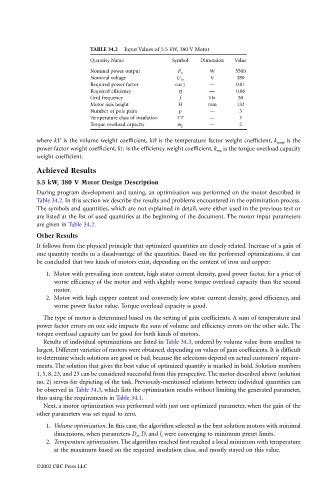Page 1012 - The Mechatronics Handbook
P. 1012
TABLE 34.2 Input Values of 5.5 kW, 380 V Motor
Quantity Name Symbol Dimension Value
Nominal power output P n W 5500
Nominal voltage U 1n V 380
Required power factor cosj — 0.81
Required efficiency η — 0.86
Grid frequency f Hz 50
Motor axis height H mm 132
Number of pole pairs p — 3
Temperature class of insulation TT — F
Torque overload capacity m p — 2
where kV is the volume weight coefficient, kϑ is the temperature factor weight coefficient, k cosϕ is the
power factor weight coefficient, kh is the efficiency weight coefficient, k mp is the torque overload capacity
weight coefficient.
Achieved Results
5.5 kW, 380 V Motor Design Description
During program development and tuning, an optimization was performed on the motor described in
Table 34.2. In this section we describe the results and problems encountered in the optimization process.
The symbols and quantities, which are not explained in detail, were either used in the previous text or
are listed at the list of used quantities at the beginning of the document. The motor input parameters
are given in Table 34.2.
Other Results
It follows from the physical principle that optimized quantities are closely related. Increase of a gain of
one quantity results in a disadvantage of the quantities. Based on the performed optimizations, it can
be concluded that two kinds of motors exist, depending on the content of iron and copper:
1. Motor with prevailing iron content, high stator current density, good power factor, for a price of
worse efficiency of the motor and with slightly worse torque overload capacity than the second
motor.
2. Motor with high copper content and conversely low stator current density, good efficiency, and
worse power factor value. Torque overload capacity is good.
The type of motor is determined based on the setting of gain coefficients. A sum of temperature and
power factor errors on one side impacts the sum of volume and efficiency errors on the other side. The
torque overload capacity can be good for both kinds of motors.
Results of individual optimizations are listed in Table 34.3, ordered by volume value from smallest to
largest. Different varieties of motors were obtained, depending on values of gain coefficients. It is difficult
to determine which solutions are good or bad, because the selections depend on actual customers’ require-
ments. The solution that gives the best value of optimized quantity is marked in bold. Solution numbers
1, 5, 8, 23, and 25 can be considered successful from this perspective. The motor described above (solution
no. 2) serves for depicting of the task. Previously-mentioned relations between individual quantities can
be observed in Table 34.3, which lists the optimization results without limiting the generated parameter,
thus using the requirements in Table 34.1.
Next, a motor optimization was performed with just one optimized parameter, when the gain of the
other parameters was set equal to zero.
1. Volume optimization. In this case, the algorithm selected as the best solution motors with minimal
dimensions, when parameters D e , D, and l i were converging to minimum preset limits.
2. Temperature optimization. The algorithm reached first reached a local minimum with temperature
at the maximum based on the required insulation class, and mostly stayed on this value.
©2002 CRC Press LLC

